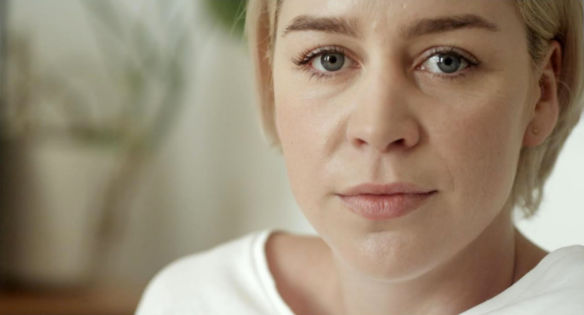This was published 6 years ago
When you think of someone with HIV, you don't think of Abby
By Mary Ward
The date is February 24, 2012, and Abby Landy is sitting in a doctor's office, receiving the result of an HIV test.
It's positive.
With her knowledge of the condition based on 1980s rhetoric like the now infamous "Grim Reaper" television ad, Landy says she was "terrified".
"I had no idea about what it meant to have HIV in 2012. I had the same sort of preconceived ideas people often have about HIV and AIDS: basically that, if you get it, you die."

When she was first diagnosed as HIV positive, Abby Landy had no idea she would be able to have sex with her partner with no risk of transmission.
When you think of people who live with HIV, people like Landy, a lawyer, rarely come to mind: she is a woman, who contracted HIV from a previous male partner.
"People think HIV only affects a certain type of person," she says. "But HIV doesn't discriminate – the 'H' in HIV stands for 'human'. It doesn't discriminate based on sexual preference or gender."
UNAIDS estimates there are about 25,000 Australians living with HIV. About 10 per cent are women.
While gender breakdown is typical in western nations where clean needles are available and the sex work industry adopted safe practices early (HIV rates in the Australian female sex worker population are less than 0.1 per cent), women account for more than half of the 36.7 million people living with HIV worldwide.
Now 29, Landy says she would never have thought that, on treatment, she would be able to safely have sex with her partner, as well as fall pregnant without risk of transmitting to her child.
"It totally shifted my perception of what [having HIV] meant," she says.
Landy is sharing her story for a new campaign from HIV organisation The Institute of Many titled "U=U": undetectable equals untransmissible.
An offshoot of a global campaign, it aims to raise awareness in Australia that, once a person with HIV achieves an undetectable viral load – measured as fewer than 50 copies of the virus per millilitre of blood – through antiretroviral treatment, there is no risk they will transmit the virus through sexual activity or pregnancy.
Professor Sharon Lewin, from the University of Melbourne's Doherty Institute for Infection and Immunity, says that while it varies from person to person, people living with HIV generally achieve an undetectable viral load – measured through a blood test – after a month of taking antiretroviral medication.
"By six months we would expect nearly every patient to have an undetectable viral load. If a patient didn't have an undetectable viral load by six months, we would then look at changing their treatment."
While studies dating back to 2010 have suggested that transmission is greatly reduced on treatment, two recent studies have shown that having an undetectable viral load means there is no risk of transmitting HIV through sex: PARTNERS, an observational study of European heterosexual and male homosexual partners conducted from 2012 to 2016, and Opposites Attract, a study of homosexual men in Thailand, Brazil and Australia over the same period published by UNSW's Kirby Institute last year.
"Together, that data tells us that the risk of transmitting the virus sexually, if your viral load is undetectable, is zero," Professor Lewin says.
The findings were endorsed by the International AIDS Society last year.
There has been much buzz around pre-exposure prophylaxis (PrEP), an antiretroviral drug taken by HIV negative people to protect themselves from the transmission of HIV. After being approved by the Therapeutic Goods Administration in 2016, federal health minister Greg Hunt announced PrEP would be subsidised by the Australian Government through the Pharmaceutical Benefit Scheme from April 1 in a press conference yesterday.
But Landy wishes more people were aware that people living with HIV are also able to protect others from transmission.
"People are shocked and amazed that I can have sex without transmitting when I tell them," she says. "They just don't know."